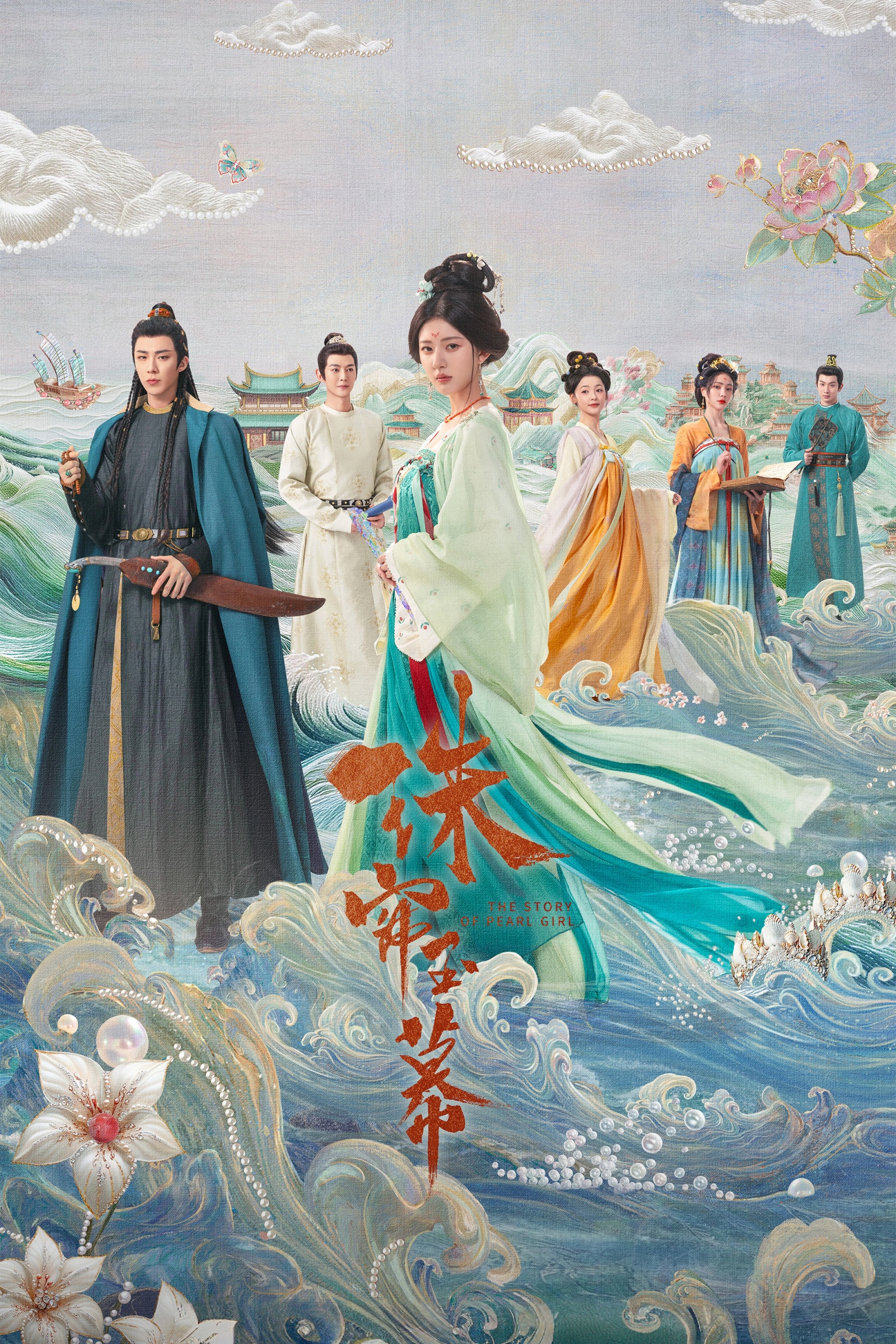
Director Xie Ze's creative journey begins with a deep interpretation and reconstruction of the script. When he first received the screenplay for Beaded Curtains and Jade Screens, he felt as if he had discovered the map to a mysterious treasure, keenly sensing the immense potential it held. He realized that this script was not just a simple story framework but rather a game map guiding the characters through the challenges of entrepreneurship. In his eyes, the characters in the script are vibrant beings, each with their own soul and mission, and his responsibility is to give these characters a more realistic and fuller embodiment, leaving a profound impression on the audience.

Poster of Beaded Curtains and Jade Screens
In his thorough reading of the script, Xie Ze did not rush into action; he resolutely abandoned the conventional approach of turning the drama into a “period romance,” determined instead to infuse it with a greater sense of realism. He firmly believes that only by rooting the story in the soil of reality can it truly blossom.
Throughout the growth journey of the protagonist, Duan Wu, Xie Ze devoted extensive effort to shaping this character, hoping to make her more authentic and three-dimensional. He understands that a character’s growth is not an overnight process; it requires experiencing countless setbacks and hardships to transform from naivety to maturity, from fragility to strength. Therefore, starting from the script, he designed a growth path for Duan Wu that is filled with struggles and challenges. This drama has also become one of actress Zhao Lusi's most ambitious and challenging works in recent years.
Xie Ze's relentless pursuit of authenticity is not limited to character development; it permeates the entire creative process. In selecting and constructing shooting locations, he strives to restore the historical landscape, creating an immersive ancient world for the audience. For example, to create a realistic underwater scene, Xie Ze and his team invested a great deal of time and energy.
“Our underwater scene is a vital part of the drama, and we started preparing it about two months before filming began. We found a swimming pool in Hengdian, raised the height by 5 meters with concrete and steel bars, drained the water, and started building the set. We watched numerous underwater reference videos to find the most suitable and beautiful seabed, and then we began constructing the 'underwater world,'” Xie Ze recalled.
During this process, although they faced numerous difficulties, such as water contamination and temperature control, he maintained his resolve. “We repeatedly drained the water to reduce underwater sediment, stirred the sand, and each time we carried out the experiments about seven or eight times before we achieved the best shooting effect. We also controlled the water temperature; if the water exceeded 28.5 degrees Celsius, it would become dirty and murky. We conducted extensive temperature experiments before we began filming.”
From the arrangement of the sand and rocks on the seabed to the placement of various biological models, every detail was meticulously scrutinized and crafted. Throughout this process, they encountered numerous difficulties and challenges, yet Xie Ze never gave up, ultimately creating a visually realistic underwater world using live action rather than effects, providing the audience with a novel visual experience and becoming a significant highlight in the early visual presentation of Beaded Curtains and Jade Screens.
At the end of the interview, when discussing the issue of Chinese dramas going global, he expressed that works like Beaded Curtains and Jade Screens, which contain elements of traditional Chinese culture, can certainly pique the curiosity and affection of global audiences. However, he emphasized that the “truth” of the characters and story serves as a bridge that transcends cultural differences. Regardless of their origins, people can find resonance in heartfelt and genuine stories. “Human nature transcends cultural differences; no matter the skin color, human nature is universal.”

Director Xie Ze
[Dialogue]
“I sincerely hope that the characters in the drama can bring strength to everyone”
Pengpai News: When you first read the script, what special feelings or thoughts did you have?
Xie Ze: Upon my first reading, I felt that the script for Beaded Curtains and Jade Screens resembled a map, showcasing all the places Duan Wu traveled while starting her business. When I read it a second time, I paid particular attention to the characters. They underwent significant revisions to be more grounded, emphasizing realism. For example, Duan Wu's childhood in Zhu Nu Cave in Hepu was not overly elaborated upon, yet Zhu Nu Cave was dark and cruel; with the switch to the opulent scene of the Pearl Society, the contrast allows the audience to feel the disparity between the life of the nobility, thriving amid prosperity, and the tragic existence of slaves.

Still from Beaded Curtains and Jade Screens
Pengpai News: Indeed, the early narrative and environment highlight the sufferings of the pearl divers, giving the audience a sense of the protagonist's predicament as very real.
Xie Ze: Exactly. A person with nothing initially just wants to survive. After staying alive and experiencing various tragedies in life—partings, intrigues, and being oppressed—that's when her inherent spirit is ignited. “Don’t leave Yangzhou; otherwise, you will end up in eternal damnation,” she originally said, “I have long since reached eternal damnation,” which embodies her inherent resilience and fighting spirit, common among the struggling poor. We must fight to live, leaving no fear for the future. By the latter part of the drama, the protagonist's perspective shifts towards a greater cause for family and nation. The first half is about survival and freedom.
This is the so-called growth trajectory; she begins as a soulless shell—a slave, struggling to find meaning in life. Gradually, she discovers the significance of her existence and aspires to live better. Once she finds success, she can build her own business and help others. This is a well-rounded narrative; it's not that the protagonist starts off as a saint, suddenly thinking of saving others, which most people find hard to relate to. Everyone has their own struggles, and I sincerely hope the characters in the drama can empower the audience, showing us how to break free from our predicaments. This emotion can resonate strongly with us.

Still from Beaded Curtains and Jade Screens
Pengpai News: The characters in the series have complex fates, rapidly switching careers and settings. It has been said that the heroine changed jobs three times within the first three episodes—from a slave, to a pearl-selling online streamer, to a novice worker on a merchant ship, which feels like playing a game.
Xie Ze: I enjoy strong narratives and fast-paced storytelling, and I believe the audience will appreciate this as well. However, the twists in personal destinies, the switching of careers, rapid changes in scenes, significant events occurring—all possess external motivations bolstered by the characters' internal drives. We provide the audience with a reasonable explanation for each twist. For example, her transition from a slave to a pearl seller is natural; her mother secretly assists her, getting her a position as a maid to escape the situation and survive.
We have exciting stories ahead, and it’s crucial not to drag the pace in the early episodes. These days, many dramas are very fast-paced, delivering information right off the bat while gradually allowing the audience to understand the story.

Still from Beaded Curtains and Jade Screens
Creating an "Underwater World"
Pengpai News: After watching the first two episodes of Beaded Curtains and Jade Screens, I am particularly interested in the underwater scenes, as filming underwater is challenging, often involving a lot of special effects, as well as difficulties in set construction and shooting underwater. I noticed the restoration and realism of the underwater scenes are particularly high, and I would like to hear about your efforts in filming those scenes.

Still from Beaded Curtains and Jade Screens
Xie Ze: Our underwater scenes are a highly significant part of the drama; we started preparations about two months before filming began. We visited various underwater filming studios in Guangzhou, Wuxi, Xiangshan, Beijing, and Hengdian.
We then began crafting the "underwater world"; since those materials would cause contamination, we sought completely pollution-free materials, as contaminated materials would make the water murky. We first experimented with a 2m x 2m water tank, creating props and placing them in the water tank to see if they would cloud the water and extracting water samples for quality checks every three days. Only after ensuring the water was safe for humans did we start mass production of the underwater decorations, securing them to the seabed.
We also sourced sand from Hepu, Guangxi to lay on the bottom. Of course, after pouring in water, the major issue was that the sand was clear when calm, but whenever someone dove in, the water would turn murky. We drained the water repeatedly, stirred the sand, lowered half the amount, and conducted these experiments seven or eight times before reaching a satisfactory effect.
Prior to filming, we practiced all the underwater sequences on land, reviewing the footage, removing what we felt was unworthy, retaining the good clips, and discussing any additional shots needed for reshoots. Once all underwater moves and camera angles were finalized, we showed them to the actors to minimise shooting time while maintaining safety. Therefore, we managed to film quickly; the challenging part was in the preparation stage.
Pengpai News: So what we see in terms of the underwater fight scenes was first practiced on land, set in a defined format before being handed to the actors for underwater filming, thus greatly enhancing efficiency and safety?
Xie Ze: Exactly. This approach minimizes unnecessary shots and time wastage, and with reference movements available, actors can perform with greater clarity. We also installed underwater communicators, allowing us to talk from the surface while they could hear it underwater. Once we confirmed a shot was successful, we would knock on metal pipes to signal them to surface.
I remember a scene where the antagonist chokes Duan Wu, and we had to depict Zhao Lusi struggling for breath. We also planned for any potential dangers; if there were risks, she was to signal us immediately to bring her up.

Still from Beaded Curtains and Jade Screens
Pengpai News: I haven’t seen Zhao Lusi in such roles before. I’d like to talk about her performance—did she initially exhibit any fear, and how did you help the actors overcome concerns about filming such intense scenes?
Xie Ze: In reality, we anticipated too much, worrying about her being unable to swim or suffocating; everyone was concerned for her. Quite the opposite, she reassured everyone with every take, saying she was fine. When she first entered the water, she was uncomfortable, and her lips turned purplish; it was evident she was shivering. All the staff were worried and asked if she could manage; if not, she could come up. She kept saying it was okay, constantly reassuring us.
She would often film all day with underwater work being particularly troublesome; with


